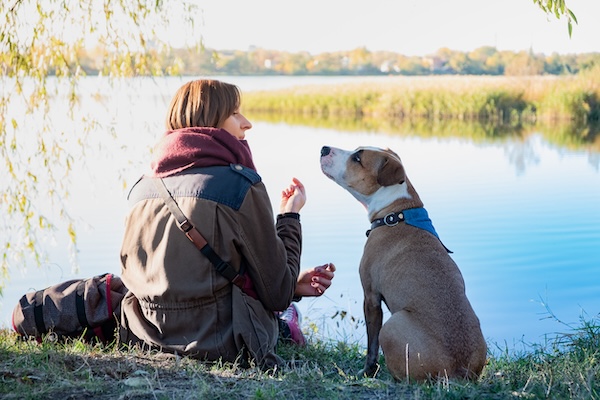We all do it. We talk to our dogs throughout the day, holding long conversations as if they’re humans that understand us. But is this chatty behavior odd? Do dogs even like it when we speak to them, or are they just patronizing us? And if you really want to connect with your dog, do the “talk to dogs” apps work to bridge the human-to-dog “language” gap? Let’s explore what the science says.
Is it Weird to Talk to Your Dog?
No. Actually, it’s weird not to. In a survey by Preply, 84% of the 1,500 U.S. pet parents interviewed across the country said they talk to their dogs regularly.
Of those surveyed, 65% said they speak to their dogs in a higher-pitched tone than usual, and 56% said they used baby talk. Some (37%) also said they sing or read stories to their pet or use technology (16%) like pet cameras to communicate.
And if you imagine your pup has a particular sounding speaking voice, say one that sounds like a celebrity, you’re not alone. One in four pet parents surveyed said they think their dog would sound like Tom Hanks, while 15% said Betty White.
Do Dogs Like When You Talk to Them?
Now we know that everyone is talking to their dogs. But do our pups even like it? Again, research says yes, suggesting that speaking to our furry family members not only gets their attention but can also help build a relationship with them. However, the way we speak to our dogs and what we say also matters.
Studies show dogs respond best to baby talk
In 2018, the University of York conducted a speech experiment to investigate “dog speak,” similar to how adults talk to babies in a high-pitched tone with a slower tempo. They also examined how pet parents often speak to dogs, using simple vocabulary and phrases (think “Who’s a good boy?”).
During the study, the speakers also mixed the two. Sometimes, they would talk to the test dogs in a baby voice/dog speak and say non-dog-related phrases like “I went to the movies last night.” Other times, they’d have the speakers talk normally and use dog-related words like “Do you want to go for a walk?”
Researchers found that when the speaker used dog speak and dog-related words, the test dogs wanted to interact and spend more time with them. But the dogs had no real preference when they mixed up the two. This data suggests that dogs need relevant words spoken to them in a high-pitched, emotional tone to find them pertinent.

Photoboyko via iStock
Do “Talk to Dog” Translation Apps Work?
But what if you want to go deeper than the simple cues to communicate with your dog? Should you use one of the “talk to dog” apps that promises to translate what your dog says and vice versa? The short answer is that most of these apps are for sheer entertainment, and you’d be better off learning dog body language. But that doesn’t mean they don’t hold potential for the future.
Some scientists think technology could someday help pet parents understand their dogs better—like Con Slobodchikoff, animal behaviorist, conservation biologist, and professor at Northern Arizona University. His vision, though, is a dog app that would use artificial intelligence to build a catalog of behavior and then translate it for you in English or another language. For example, if a dog suddenly shakes off during a training session, the app might say, “I’m frustrated right now.”
Others, like Kevin Coffee, a neuroscientist at the University of Washington, are looking at how to use technology to decipher animal sounds. Building an AI model called DeepSqueak, he’s recorded the squeaks and squeals of mice and rats to try to figure out how the animals felt. His research at this point, however, hasn’t yet figured out how to disclose what the rodents are trying to communicate (maybe “Give us cheese?).
So, Should You Talk to Your Dog?
Absolutely! Your dog will always love and appreciate that you’re trying to communicate with them. And until there’s a true dog translation app, the best way to speak to our pups is by using words they know in a high-pitched voice. Understanding dog body language is also a fantastic communication tool.
But don’t let the data and details hold you back from being silly and strange with your pet. There’s no shame in singing, reading, and telling your dog about your day, too. After all, they are our family members and fellow weirdos. They’ll just be happy to spend more time with you, even if you think they sound like one of the Golden Girls.




